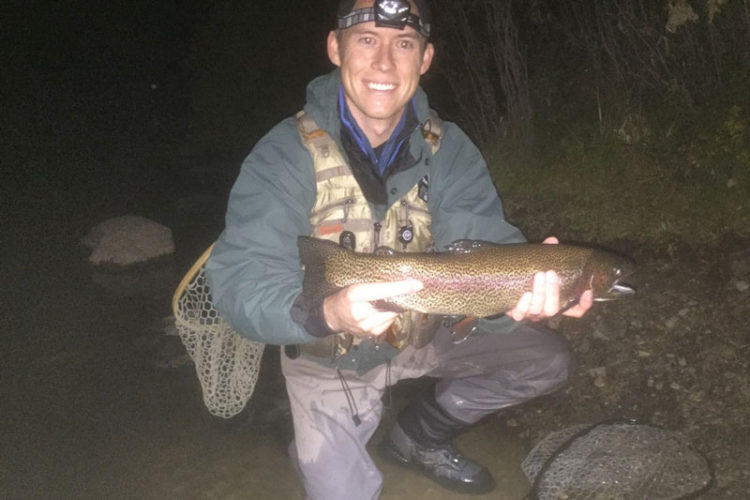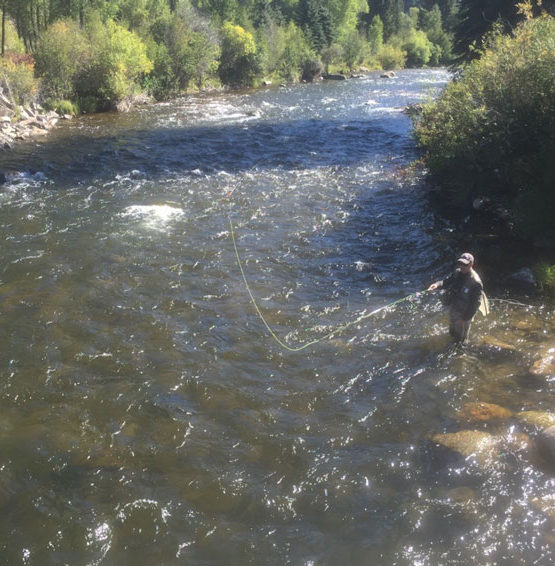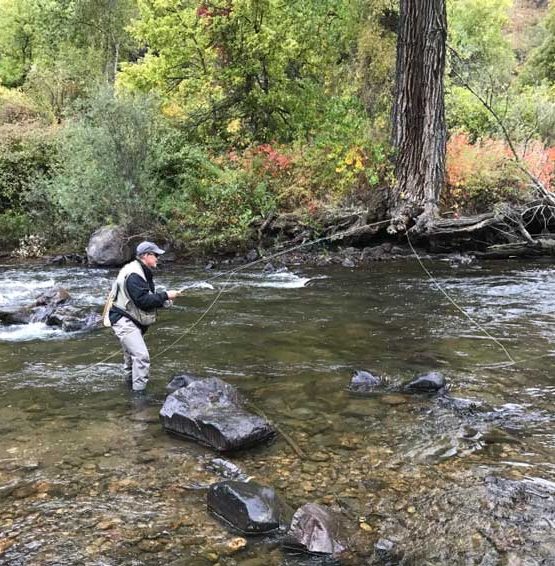To put it mildly, the giant rainbows and browns that make The Hog Trough their home are dang hard to catch. The famed uppermost stretch of Colorado’s Taylor River tailwater boast some of the most hefty yet altogether wily trout in the world. And it’s no wonder; given that section of river’s legendary status, they see as many artificial flies as a mangy dog sees fleas.
But, despite the near-inevitability of an elbow-to-elbow afternoon with fifty of our closest fly fishing friends, we always commit an afternoon or two to try to outwit just a few of them. That afternoon is best described as an exercise in abject futility, as slab-like trout pop and breech all around you, hitting everything that flies, wriggles or flops in the water, as long as it’s not connected to your or anyone else’s line!
But that all changes as the sun goes down and, with it, Taylor River trout IQs. Learning this tasty tidbit from the grizzled vet behind the counter at the Willow Fly Angler in Almont, Colorado may have been the single best local tip we’ve ever received. And so, after dinner, a short nap and a twisty drive up Taylor Canyon, we geared up, riverside, amid a scant few other fly-fishing freaks who dared a 10 P.M. whack at these now-foolhardy fish.
With newly-purchased headlamps firmly affixed, we made our way down the bank, through the creepy willow-shrouded trail and waded, just the two of us, father and son, into the black flow of the most coveted bend on The Trough. Taking adjacent positions just a mere cast-length apart, we began our newest fly fishing adventure, and this is precisely when things got outlandishly surreal.
Aside from the more-frequent-than-you-want-it-to-hit-you notion that you’re being stalked by either a hungry mountain lion or haunted by the ghost of Jacob Marley, the first thing we quickly realized was that, in a pitch black night sky, flying insects concentrate around the nearest light source (duh!) and, secondarily, bats concentrate around flying insects. Do the math and it’s rather easy to imagine two guys with bright lights strapped to their heads, standing in a river, fly fishing amid swarms of moth-like insects and swooping, not afraid to brush your ears, bats. If that Indiana Jones style scene freaks you out, night fishing the Taylor River might not be the adventure you’re looking for.
In our case, it became easy to overlook, as within about three minutes, we both had hooked up on a couple of those rather large and feisty trout that had certainly been among those that had thumbed their noses at our offerings all afternoon. “Ha!” I thought, “I have you now!” And we did. And we did, and we did and did and did, until our lamps grew dim, our forearms wore out and our need to sleep outweighed our need to catch another trout, which, incidentally wasn’t until about three hours and forty to fifty fish (each) later. It had been, in a word, silly.
As we made our way back to the truck and then back down the slumbering Taylor River valley, we fought heavy eyelids with disbelieving laughter, utter amazement at what had just happened and an unsettling understanding that, even among those who know us to be men of character, our story might trigger many an eye-roll.
If this absolutely true story has you jonesing to give this adventure a try, here are 11 things you need to know about night fishing the Taylor River.
Related Content:
- 5 Great Places To Catch Kokanee Salmon In Colorado
- Why Is Fly Fishing Addictive?
- 25 Best Dry Flies For Colorado Fly Fishing
- How To Read A River: 9 Tips To Catch More Trout
- San Juan Worm: Fly Pattern Profile
Dress Warm
The Colorado mountains are cold at night. It doesn’t matter what time of year it is or how warm it’s been during the day, the temperature plummets when the sun goes down. Add a little dash of rain, a pinch of wind, a measure of sweat and then stand, hip-deep in a river bourn of melting snow for a few minutes and, if you haven’t bundled up, your night fishing adventure is going to end before it really gets started.
Worse yet, you may get so involved in your trout catching festivities that, if underprepared, you tempt a hypothermic catastrophe.
Here’s a tip: if you think you’ve over-dressed in cold weather gear, add another layer. You can always take off an item or two if you get too warm, but don’t let something so easily preventable spoil your fun.
Don’t Fly Fish Alone
This is a good rule of thumb for just about every fly fishing or wilderness outing situation. Although we all think ourselves bulletproof, we aren’t. A slip of the foot results in a slipped disc. Climbing over a log turns into a contused knee. Trudging through stream-side brush kicks up a hornets nest or ticks off a rattlesnake and, suddenly, Mr. Bulletproof becomes Mr. I’m Up Crap Creek Without a Paddle.
Aside from these potentially dangerous situations, it’s more fun to fish with friends and, after all, taking nighttime selfies while trying to pose with a slimy trophy trout in hand isn’t going to come out well. Fishing alone is stupid. Don’t be stupid.
Use A Good Headlamp (With Several Modes):
The adage, you get what you pay for, comes strongly into play when it comes to headlamps.
The first time my son and I went night fishing on the Taylor, to save a few bucks, we bought low-quality headlamps. I think they had two modes: on and off, and had maybe two light casting angles: up and sort-of-up. What can I say? We were desperate, and the nearest store that carried cheap headlamps was a Walmart ten-miles-away.
Something else we found out the hard way was that headlamps chew through batteries like beavers do aspens. Happily, these cheap-o headlamps lasted us through our first night… barely.
Had we not quit when we did, we’d have only had about ten more minutes before we were making our way back to the truck in utter darkness.
Don’t scrimp on this vital piece of equipment. Look for high-quality LED headlamps with long battery life, several light-type and lighting angle modes, and don’t forget to take the batteries out of them as soon as your trip is over.
Here’s an extra tip that you’ll thank us for later: make sure one of the light modes is red. When tying on a new fly, it’s nice to have, A. Light on your knot-tying work and, B. Fewer insects flying around your eyes. The red light mode affords both.
Bring Extra Batteries (For Your Headlamp)
If you’re enjoying an epic night of fly-fishing success, you’ll become rather bummed rather quickly if your headlamp is running out of juice.
Pack away a complete set of batteries in your vest or sling-pack (most good headlamps need four AAAs) and if your headlamp begins to dim, banish your inner cheapskate and switch out the whole lot of ‘em at once. Trust me on this one.
P.S. Don’t switch out batteries on the water. You certainly know why. Find a riverside dry spot and do it there.
Wear Clear Protective Glasses To Keep The Bugs Out Of Your Eyes
I wear glasses, my son, contacts. Neither one of us was prepared for just how many fluttering insects gathered around our light sources in the dead of night. Didn’t think that one through, we both thought, as we battled to clear our field of vision while hauling in trout after trout.
Harmless though they were, these flies were a total nuisance and, yes, they did find their way into our eyeballs from time to time. Icky but easily remedied with a pair of clear protective glasses you can find at any hardware store. For those of us who don’t like contact lenses, prescription sport specs make a great alternative.
Oh, and lest I forget, the whole daytime polarized sunglass thing doesn’t even come into play when fly fishing at night. In fact, just like the flying insects orbiting around our heads, trout, as it turns out, are just as attracted to light sources (and/or the bugs the light sources attract). Either way, you’ll be utterly amazed when, after just a few minutes, you’ll see and feel tons of healthy brown and rainbow trout swirling around and bumping into your legs.
Sun glare just ain’t there! Simply put, it’s a wild thing to witness!
You Might Catch A Bat
Early on, in our first nighttime fly fishing adventure, my son caught something that wasn’t a trout. His first clue? He didn’t catch it in the water! In fact, he wasn’t sure what he’d snagged in his backcast but, as his forecast landed with an odd splash in the black flow in front of him, it was clear that this wasn’t your typical willow branch. Reeling it in and reaching down to grab and un-snag whatever he had “caught,” he about shot out of this waders when the dark glob grabbed him back!
Creepy as hell but, yes, he’d caught a bat… the first of three he’d hook that night. A long and hilarious story — fodder for another post — let’s just say he learned, in spades, what happens to one’s rig when a freaked out, floppy, wriggly bat gets tangled up in one’s fishing line.
If this should happen to you, here’s the simplest, most elegant solution: carefully cut it loose and re-rig. Alternatively, if you so choose, try to do something more humane and risk a rabid bat bite, losing thirty minutes of fishing time and, sometime later, turning into a vampire.
Honestly, who really needs that in their life?
Stock-up On Mysis Shrimp
As noted previously, the upper stretch of the Taylor River, just below the spillway of the Taylor Reservoir, is a fairly slow moving, smooth stretch of water that is the home to some of the largest trout you’ll ever see.
How do they get this big?
Like any trout: a steady flow of aquatic-born flies, a variety of worms, scuds, terrestrials and MYSIS SHRIMP! Therefore, the local fly shops stock a healthy supply of Mysis imitations. If you’re planning to fish the Taylor at night, you should too.
Feel free to test other fly, nymph, scud or worm imitations, but never veer too far from the mysis shrimp. You’ll thank us for this advice when you’ve just netted your twenty-fifth, eighteen-inch (plus) trout and you begin to wonder if you’ll need surgery to remove the goofy perma-grin from your face!
Fish Without A Strike Indicator
Remember the bats? How could you forget them? Remember how I told you that they were attracted to the insects that were drawn to our headlamps? Well, I left out the fact that they were also attracted to our strike indicators.
Everyone with grey matter knows that bats are basically blind, but that they are also equipped with the most sophisticated sonar system of anything else on earth. Thus, a strike-indicating bulb flying back and forth through the night sky is a natural bat attractor.
Again, do the math, remembering that my son caught three of the little buggers, and you’ll understand why we removed our strike indicators to, in essence, fish by feel. Truthfully, fishing by feel is pretty easy when nearly every cast and decent drift draws a take, but it’s still a huge ego stroke to catch large trout, Kung Fu style, by pure feel.
Next time you find yourself catching millions of trout, in the dark, on the Taylor, in the surrounding beauty of a Colorado night sky, give it a try!
Crimp down your barbs
I confess, I don’t always crimp down my barbs. Sometimes I forget to. Other times, I figure, as hard as trout are to catch on a fly, I’m not about to let them get off so easily.
Purists are going to give me hard time about this, but, one thing I know about these snooty purists is that they cheat too. They just aren’t honest enough to admit it.
That said, if you’re blessed enough to spend a night fly fishing the Hog Trough, crimp down your barbs. Do it as much for the fish as for the ease and quickness of unhooking and casting again. Every second counts when trying to beat our record!
Try Free-Netting A Trout
So, picture this. I’m caught up in my own giddiness, just casting, hooking, fighting and landing big trout after big trout when, all of a sudden, I’m strangely aware that my son, now downstream of me, isn’t laughing, hooting, reeling or netting trout anymore, at least in the traditional sense.
In fact, he’s hunched over in the middle of the river, headlamp down, sans fly rod (it’s leaning on a willow at river’s edge), with net in hand, quietly channeling his inner fish whisperer. It’s then that I realize, he’s decided, in the midst of this crazy trout petting zoo, that it’s time to try his hand at free-netting.
I’m fairly sure you know how this turns out.
Yes, after a few misses, he’s netting trout without a rod, reel or fly. It was altogether mesmerizing. So, of course, not to be outdone by my once, long-ago, fly fishing pupil, I had to try it myself. And while I didn’t catch any bats that night, I didn’t free-net any dang trout either!
Be mindful of nocturnal predators
I don’t know how many mountain lions or bears were prowling around in the vicinity of our night fishing extravaganza, but, when I stopped to ponder it, my mind conjured about fifty of them.
Picture a quintessential Halloween scene, when all you see shining through the darkness are a plethora of bright orange predatory eyes, blinking with evil intent, and all focused on getting you before the Headless Horseman does. Imagine this vividly and you’ll understand the unease this once afraid-of-the-dark boy felt while sitting riverside, freeing a fish or changing a rig. Flies buzzing around the head? No biggie. Bats swishing by my ears? No worries. Cats or bears attacking me in the willows. I’m out!
Be mindful of this possibility as you walk to and from your vehicle. As I tell my children all the time, be aware of your surroundings. Make noise. Scare them away. Don’t become food.
Final Thoughts
In our opinion, these are the essential elements to ensure a successful nighttime fly fishing excursion on the Taylor River. A few others include bringing snacks, plenty of water, a thermos full of hot coffee or soup and staying alert while driving back down the dark, windy mountain road to your cabin or campsite.
Save the celebratory adult beverage until you’re out from behind the wheel for the night. More than likely, you’ll be so exhausted, you won’t even want one. You’ll probably opt for a warm shower and your pillow instead.
And, if you have any trouble getting to sleep, it’s only because of residual adrenaline from the thrill of what we hope will have been one of your most memorable fly fishing adventures.
Instead of counting sheep to help you doze off, we suggest counting Hog Trough trout!
Disclaimer: This post may contain affiliate links, meaning we will receive a small commission (at no cost to you) if you click through and make a purchase.









